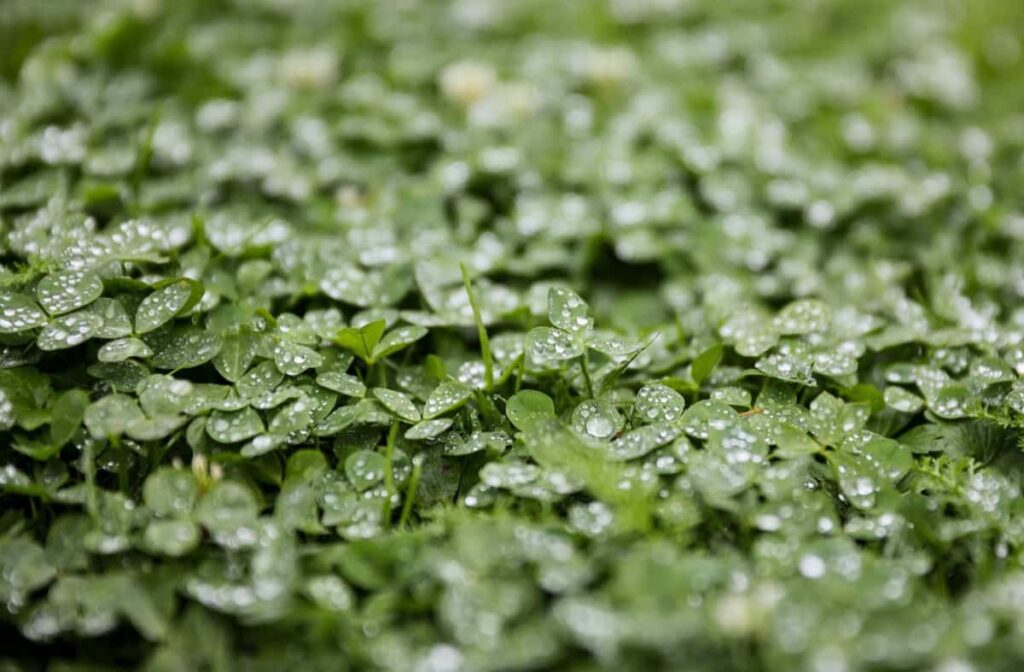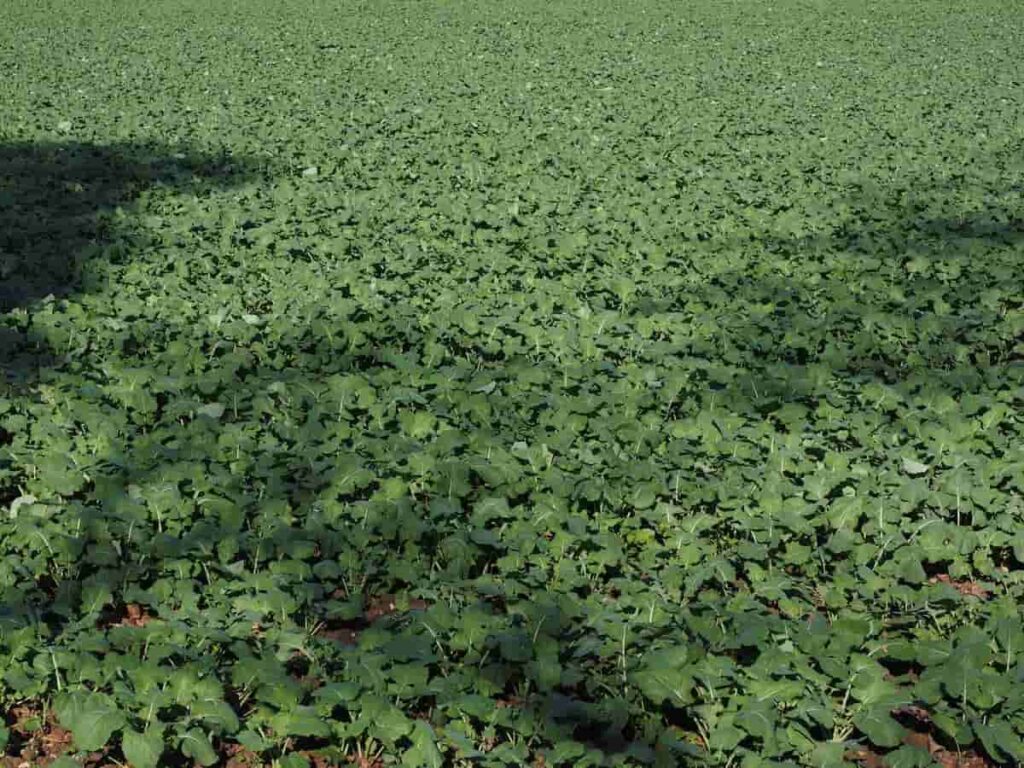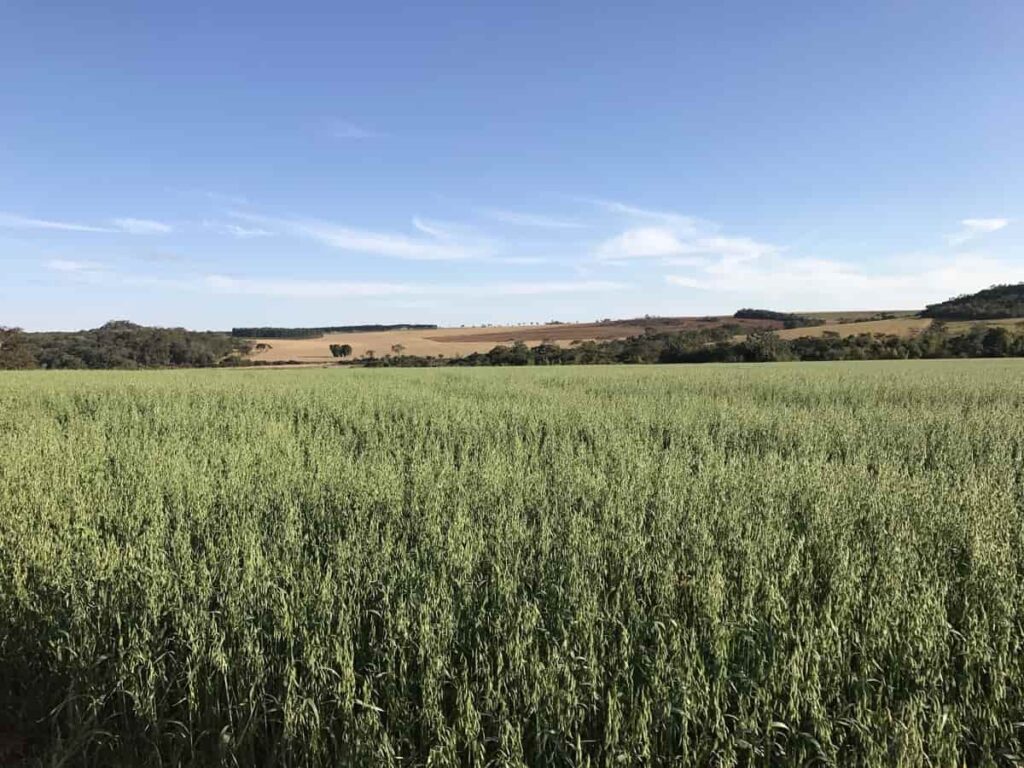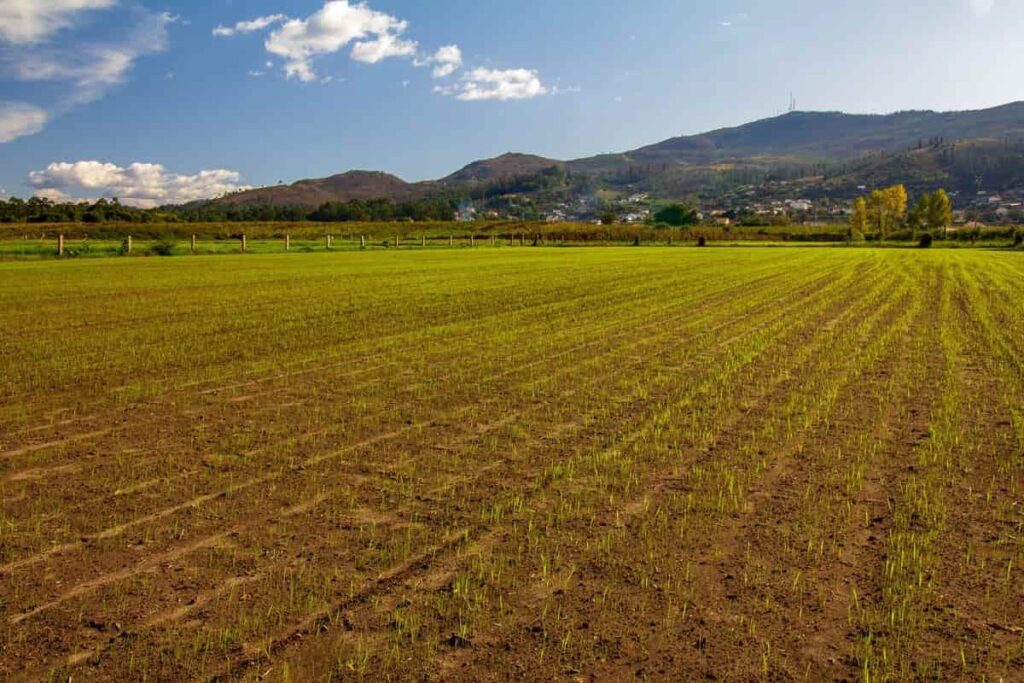There’s been a lot of talk about sustainable agriculture and the importance of using sustainable practices on farms. One of the most important sustainable practices is using cover crops. Cover crops are grown between cash crops to improve soil health, reduce erosion, and provide other benefits.

Therefore, they are an important part of any sustainable agricultural system. If you’re thinking about using cover crops on your farm, this guide walks you through all the information you need to get started. We’ll cover the benefits of cover crops, how to select the suitable species for your needs, and how to establish and manage a cover crop system.
A guide to sustainable cover crops
What is cover cropping in agriculture?
Cover cropping is the intentional planting of a crop between the main cash crops in a field. The cover crop is often a legume, such as a clover, that adds nitrogen to the soil. Cover crops can also help prevent erosion, improve drainage, and suppress weeds.
Cover crops for sustainable farming
Many different cover crops can be used in sustainable farming systems. Some common cover crops include legumes (such as clover and alfalfa), grasses (such as rye and oats), and brassicas (such as mustard and turnips). Cover crops can be used in several ways on the farm. For example, they can be planted as living mulch between rows of crops, grown as a cash crop, or used as forage for livestock.
When choosing cover crops for your farm, it is important to consider your specific needs and goals. In addition, different cover crops offer other benefits, so choosing the right mix of plants for your particular situation is iessential If you plan to plant cover crops on your farm, many resources are available to help you get started. Your local extension office can provide information on the best cover crops for your area and how to incorporate them into your farming system.
Basics of cover cropping
Cover crops are a vital part of sustainable agriculture and can be used in various ways to improve soil health. For example, cover crops can be used as a living mulch, to add organic matter to the soil, or to suppress weeds. They can also attract beneficial insects, provide forage for livestock, or improve water quality. When choosing cover crops, it is important to consider the needs of your particular farm or garden. Cover crops should be selected based on climate, soil type, and other local conditions.
You will also need to decide what kind of cover crop you want: an annual that will need to be replanted each year or a perennial that will come back on its own. Once you have chosen the right cover crop for your needs, you will need to know how to plant and care for it. Cover crops often differ from other crops, so read up on the best techniques before starting. Once your cover crop is established, you will need to monitor it throughout the season and take steps to desire.
When should I start cover crops?
There is no exact and definitive answer to this question, as it will depend on your specific circumstances and goals. However, as a general rule of thumb, you should start planting cover crops after your main crop has been harvested as soon as possible. This will give the cover crop time to establish itself before the winter months set in. If you want to achieve maximum soil health benefits from your cover crops, aim to plant them in the early spring or late fall.
In case you missed it: 22 Agricultural Apps for Smart Farming Solutions: Help with Farm Management, Soil, and Crop Yield

When should you plant a cover crop?
When deciding when to plant a cover crop, there are a few things to consider. The first is what the cover crop’s purpose is. Some cover crops, like winter rye, are planted in the fall to provide winter erosion control and improve spring soil quality. Others, like annual ryegrass, are planted in the spring to improve summer soil quality. The second thing to consider is what you want the cover crop to do for your field.
Do you want it to add organic matter? Suppress weeds? Prevent erosion? These factors will help you decide what time of year to plant your cover crop. Another consideration is what type of equipment you have available. For example, if you only have a small tractor, you may want to wait until after harvest to plant your cover crop so it doesn’t interfere with your farm operations.
Finally, you need to consider what else is going on in your field. For example, if you’re planting a cash crop, you’ll need to ensure the cover crop doesn’t compete for resources. You also want to plant a cover crop only if there’s already a lot of vegetation in your field that could harbor pests or diseases. Considering all these factors, you can determine the best time to plant a sustainable cover crop on your farm.
Preparing the ground for a cover crop
Cover crops are:
- An essential tool in sustainable agriculture.
- Providing numerous benefits to the soil.
- Crop rotation.
- Overall farm ecosystem.
To get the most out of a cover crop, it is important to prepare the ground beforehand. The first step is to determine your goals for the cover crop. For example, are you looking to improve soil health? Reduce erosion? Suppress weeds? Once you have set your plan, you can select the appropriate cover crop species. After you have selected your species, the next step is to prepare the seedbed. This means creating a smooth, firm seedbed that will allow for good seed-to-soil contact.
You want to avoid large clumps of dirt or rocks that could impede germination or growth. Once the seedbed is prepared, you can sow your seeds. You can broadcast smaller seeds by hand or with a spreader. Larger seeds can be drilled in with a seeder or planted by hand. It’s important to remember that cover crops need different amounts of water depending on the species and time of year. Make sure to give them enough water to establish themselves, but don’t overdo it – too much water can encourage disease and pests.
Cover crops benefits
Cover crops are an essential tool for sustainable agriculture. They can improve soil health, increase crop yields, and reduce the need for chemical inputs.
Cover crops can:
- Reduce soil erosion
- Improve water infiltration and retention
- Increase soil organic matter
- Improve nutrient availability and uptake
- Improve soil structure
- Promote beneficial microbial activity
- Suppress weeds
In case you missed it: Crop Insurance Role in Driving Smart Digital Agriculture in Africa

Types of cover crops and examples
There are many cover crops, each with its unique set of benefits. However, some of the common types of cover crops include:
- Grasses: Grasses are an excellent choice for cover crops because they have deep roots that help to break up compacted soil and add organic matter. These cover crops also help to control erosion and can be used as forage for livestock.
- Legumes: Legumes are another excellent option for cover crops because they enrich the soil with nitrogen nutrients, which is essential for plant growth. They also have deep roots that help to break up compacted soil and reduce erosion.
- Brassicas: Brassicas are a type of leafy vegetable that makes an excellent cover crop. They help to suppress weeds, improve soil structure, and increase organic matter.
- Clovers: Clovers are a popular choice for cover crops because they fix nitrogen in the soil, which is essential for plant growth. They also help to suppress weeds and improve soil structure.
List of cover crops
A wide variety of cover crops can be used to achieve different objectives on the farm. The most popular cover crops include annual ryegrass, hairy vetch, crimson clover, winter wheat, and oats. Each cover crop has different benefits and drawbacks that should be considered before planting. For example, annual ryegrass prevents soil erosion, but it can be challenging to control once it is established.
Hairy vetch is an excellent nitrogen fixer, but it can be very aggressive and difficult to kill in the spring. Crimson clover is an excellent all-around cover crop that is relatively easy to manage. It provides good soil coverage and helps to improve soil fertility with its nitrogen-fixing ability. Winter wheat is another good all-around crop that can provide some winter grazing for livestock if needed.
Oats are often used as a nurse crop for other more delicate plants like newly seeded alfalfa fields. The best way to determine which cover crop is best for your farm will vary depending on your specific needs and objectives. A local extension agent or conservation district staff member can help you make this decision.
Cover crops for gardens
Sustainable cover crops are an important part of any gardener’s toolkit. Cover crops can help to improve soil health, suppress weeds, and provide nutrients for your plants. Many types of cover crops can be used in the garden, each with its benefits. For example, leguminous cover crops, such as clover or vetch, can add nitrogen to the soil. Grasses, such as rye or oats, can help to improve soil structure.
And brassicas, such as mustard or rapeseed, can suppress weeds and add organic matter to the soil. The right cover crop for your garden will depend on your specific needs. Once you’ve selected a cover crop, plant it at the correct time of year and follow proper management practices. Then, with a bit of care, your garden will be on its way to being more sustainable!
Disadvantages of cover crops
Cover crops are often grown on farmland that would otherwise be left bare during the off-season. Although cover crops offer many benefits, there are a few disadvantages to consider before using them on your farm. One disadvantage of cover crops is that they can be expensive to establish and maintain. Cover crops also require extra management, as they need to be seeded, watered, and harvested at the right time. In addition, cover crops can become weedy and difficult to control if not managed properly.
In case you missed it: Agriculture in Uganda: Types, Importance, Crops, and Statistics

Another downside of growing cover crops is that they can compete with the main crop for water and nutrients. This can reduce the yields and quality of the main crop. In some cases, cover crops can also harbor pests and diseases that can affect the main crop. Despite these disadvantages, cover crops can be a valuable tool for sustainable agriculture. Cover crops can help improve soil health, reduce erosion, and increase crop yields in the long term when combined with other practices such as crop rotation and diversification.
What is the most common cover crop?
There are many cover crops, but the most common is the annual ryegrass. It is an inexpensive crop that can cover various soil types. Ryegrass is also known for suppressing weeds and improving soil tilth.
What is the fastest-growing cover crop?
Of all the different types of cover crops, legumes are some of the fastest-growing. Leguminous cover crops include beans, peas, lentils, and alfalfa. These plants can fix nitrogen from the atmosphere into a form other plants can use. This makes legumes an excellent choice for sustainable agriculture as they can help reduce or eliminate the need for synthetic nitrogen fertilizers.
Other fast-growing cover crop options include annual ryegrass, buckwheat, and sorghum, sudan grass hybrids. These plants can provide a quick growth spurt before being terminated and incorporated into the soil. This can help break up compaction, improve drainage, and increase organic matter content in the short term. In the long term, these cover crops can also help build up soil health to be more resilient to drought and other stresses.
Do cover crops come back every year?
Cover crops are an important part of sustainable agriculture, but many farmers need to figure out how they work. For example, do cover crops come back every year? Yes, cover crops can come back every year. However, choosing the right cover crop for your climate and farm is essential. Some cover crops, like annual ryegrass, will only last one season. Other cover crops, like hairy vetch, can last two or more seasons. The length of time a cover crop will last also depends on how you manage it.
For example, if you till a cover crop into the soil at the end of the growing season, it will likely decompose over winter and will not come/grow back in the spring season. However, if you leave the cover crop above ground, it may reseed itself and come back next year. When choosing a cover crop, it is important to consider your farm’s needs. What are you trying to achieve with cover crops? Do you want to improve soil health? Suppress weeds? Attract pollinators? Once you know your goals, you can choose a cover crop to help you achieve them.
Cover crops in winter
There are several different things that farmers can do with cover crops in the winter. One option is to let the cover crop keep growing, providing grazing for livestock or habitat for wildlife. Another option is to terminate the cover crop by mowing it down or using a herbicide. This frees up the land for other uses, such as planting a winter crop. Finally, farmers can leave the cover crop alone, which allows it to protect the soil and improve its fertility.
What is the cheapest cover crop?
There are factors to consider when deciding which cover crop is cheapest, such as the cost of seeds, the length of the growing season, and whether or not you need to purchase additional inputs like fertilizer. For example, some of the cheapest cover crops to grow are small grains like rye and oats. On the other hand, legumes like clover and alfalfa are inexpensive but may require more management than small grains.
Do cover crops make soil healthier?
Cover crops are an important tool for farmers looking to improve the health of their soil. Farmers can add organic matter to their soil by growing a cover crop, improving soil structure, and increasing water infiltration and retention. These benefits can lead to healthier soils that can better support crop production. While cover crops can be a valuable addition to any farm operation, they are especially well-suited for sustainable agriculture systems.
Sustainable agriculture relies on practices that protect and enhance natural resources, including soils. Cover crops can play a key role in sustainable agriculture by helping to build healthy soils that are more resilient to environmental stressors like drought. If you’re interested in using cover crops on your farm, there are a few things to consider. First, you’ll need to select the right cover crop for your needs. Many kinds of cover crops are available, each with its own benefits. You’ll also need to consider when and how you’ll plant your cover crop.
Some cover crops can be planted in spring or fall, while others need to be planted in summer. Once you’ve selected the right cover crop for your farm, you’ll need to ensure it gets off to a good start. This means providing the cover crop with adequate water and nutrients. It’s also essential to monitor the progress of your cover crop so you can make adjustments as needed.
In case you missed it: How to Control Pests and Diseases in Tobacco Crop: Causes, Symptoms, Chemical, and Biological Management

Can cover crops replace fertilizer?
Cover crops are grown between cash crops to improve soil health and provide other benefits. In addition, some farmers are using cover crops to reduce their reliance on fertilizer. There are several reasons why farmers should consider using cover crops as a replacement for fertilizer. One reason is that cover crops can help to improve soil health.
Healthy soil has a better structure and can hold more water and nutrients, leading to improved crop yields. In addition, cover crops can help to control weeds and pests, which can further reduce the need for chemical inputs like herbicides and insecticides. Another reason to consider using cover crops is that they can help sequester soil carbon. This helps to mitigate climate change by reducing atmospheric CO2 levels.
Cover crops can also help farmers save money on fertilizer and herbicides. Of course, some challenges are associated with using cover crops to replace fertilizer. Finding the right mix of cover crops for your specific farm and cropping system can take time and effort. In addition, some cover crops may need to be better suited to your region or climate.
Do I need to water cover crops?
Cover crops are a vital part of sustainable agriculture and play an important role in soil health. However, cover crops can be a bit tricky to manage, particularly when it comes to watering. The short answer is that you won’t need to water your cover crops unless they’re experiencing drought conditions. In most cases, rainfall will be sufficient to keep your cover crops healthy.
However, there are a few exceptions. For example, if you live in an arid climate or your cover crop is planted during a dry spell, you may need to give it a little extra water. The same goes for very young seedlings or newly germinated plants. In general, it’s best to err on the side of caution and give your cover crops a little extra water if you’re unsure. A small amount of irrigation can go a long way in keeping your plants healthy and productive.
How long does it take for the cover crop to break down?
The time it takes for cover crops to break down and return to the soil depends on several factors, including the type of cover crop, the climate, and the management practices used. The most common types of cover crops are annuals, which typically take 30-60 days, and perennials, which can take up to two years to break down completely. In addition, cover crops grown in warmer climates will decompose more quickly than those grown in cooler temperatures.
Several management practices can be used to speed up the decomposition process, including mowing or chopping the plants before they go to seed, adding some organic matter to the ground before planting the cover crops, and using a roller-crimper to flatten the plants. Regardless of your chosen method, it’s important to remember that breaking down cover crops is a natural process that takes time.
Should I let my cover crop go to seed?
When deciding whether or not to let your cover crop go to seed, there are certain things to consider. If you have enough space and time to manage the crop, then letting it go to seed can significantly add diversity to your soil and increase its productivity. However, if you need more space or time to manage the crop, it may be best to harvest it before it goes to seed. Whichever way you choose, make sure you do your own research to make the best decision for your farm!
Can I plant a cover crop in spring?
Yes, you can plant cover crops in the spring, but selecting the right crop for your region and planting date is important. In general, small grains like oats and rye are best planted in early spring, while legumes like clover and alfalfa can be planted later in the season. Consult a local agriculture extension agent to find out what cover crops best suit your area.
Where cover crops should be planted?
When deciding where to plant cover crops, there are a few things to consider. The first is the climate. Cover crops should be planted in areas that have cool winters and warm summers. This will ensure that the cover crop has enough time to grow and produce food for the soil before the winter cold sets in. The second thing to consider is the soil type. Cover crops should be planted in well-drained soils with high organic matter content.
These soils will provide the cover crop with the nutrients it needs to grow and flourish. Finally, you need to consider the amount of space you have available. Cover crops can be planted in small spaces, such as between rows of vegetables in a garden, or they can be planted in larger fields. The size of the area you have available will determine how many cover crops you can plant.
Do you till before planting a cover crop?
There is no right or wrong answer, and ultimately it’s up to the farmer to decide what works best for their operation. Both methods have pros and cons, and each has its own benefits and drawbacks. Tilling before planting can help loosen up hard-packed soils, making it easier for the cover crop roots to penetrate the ground and access essential nutrients. This can be especially beneficial in areas where the soil is compacted from heavy equipment traffic.
In case you missed it: How to Maintain the pH Levels of Hydroponic Systems: Increase, Decrease, and Stabilize

However, tilling can also lead to erosion if done excessively and can destroy important soil structure that helps support plant growth. Leaving the land undisturbed can help preserve precious topsoil, which is essential for healthy plant growth. It can also encourage beneficial microbial activity in the soil, improving plant nutrient uptake. However, this method requires more careful planning to ensure that main crops are planted in time so that the cover crop has enough time to establish itself before winter sets in.
What is the shortest cover crop to grow?
There are factors to consider when selecting the shortest cover crop to grow. The first and foremost is the climate in which you live. If you live in regions with a short growing season, you must choose a cover crop that can be planted and harvested quickly. Another factor to consider is the amount of time and effort you are willing to put into growing and maintaining your cover crop. If you are looking for a low-maintenance option, choose a cover crop that does not require much attention or care.
Some shortest cover crops include annual ryegrass, oats, buckwheat, and mustard. These crops can all be planted and harvested within a few months, making them ideal for those with limited time and resources. However, it is important to note that these crops may provide less protection or benefits than longer-lived cover crops such as alfalfa or clover. Ultimately, the best cover crop for you will depend on your specific needs and goals.
How deep do you plant cover crops?
Cover crops are typically planted between one and four inches deep, depending on the crop. Shallow-rooted crops like radishes and turnips can be planted as shallow as an inch deep, while deep-rooted crops like alfalfa and sorghum can be planted up to four inches deep.
Conclusion
Planting cover crops is an excellent option if you’re looking for a way to improve your soil health and increase crop yields. Cover crops are fast-growing plants that can help prevent erosion, provide nutrients to the soil, and attract beneficial insects. While there are many cover crops to choose from, selecting ones that suit your climate and growing conditions is important. With a bit of planning, you can easily incorporate cover crops into your existing farming operation.
- How to Raise Pigs in Your Own Backyard: A Comprehensive Guide
- Budget Friendly Sheep Shed Ideas: Cheap and Low-Cost Tips
- How Much Do Cattle Farmers Make: Revenue Streams in Cattle Farming
- Management Pests and Diseases in Your Cotton Field
- Sheep Farming Business Plan for Beginners
- Aquaponic Farming at Home: A Step-By-Step Guide
- Profitable Village Farming Business Ideas in 2024
- High-Yield Aquaculture: Fast-Growing Fish for Farming
- Effective Fish Pond Construction Techniques for Beginners
- Irrigation and Water Management in Pineapple Farming
- Blossom to Harvest: Mastering Flowering and Pollination in Papaya Farming
- Pig Fattening Essentials: From Selection to Sale for Beginners
- Raising Wagyu Cattle: A Complete Guide for Premium Beef Production
- Soil Types and Their Water Holding Capacity
- Optimizing Irrigation Schedules for Coconut Groves for Enhanced Yield
- Espresso Your Garden: Coffee Grounds for Healthier Acid-Loving Plants
- The Best Soil Mix for Snake Plants: How to Mix Your Own Snake Plant Soil
- Green Thumb Success: Expert Tips for Cultivating Greenhouse Beans All Year Round
- Bloom All Year Round: The Ultimate Guide to Indoor Hyacinth Care
- Eco-Friendly Gardening: How to Make Liquid Fertilizer from Kitchen Waste
- Ultimate Guide to Grow Anise in Pots: Explore Seed Propagation to Harvesting
- Guide to Raising Chester White Pigs: Discover Breed Facts to Growth Management
- Mastering the Elegance: The Ultimate Guide to Weeping Cherry Tree Care, Planting, and Maintenance
- Ultimate Guide to Planting Garlic in Grow Bags: Growing Strategies for Beginners
- How to Fix Spider Plant Leaf-Related Problems: Natural and Organic Remedies
- 10 Reasons Why Your Tulsi Plant is Shedding Leaves: Home Remedies and Solutions
- Optimizing Growth and Yield: The Advantages of Palm Bunch Ash Fertilizer
- Utilizing Neem Oil Extract as a Natural Pesticide for Hydrangea
- From Soil to Harvest: Various Ways in Which Farmers Can Use AI Tools
- Steps to Encourage and Induce Citrus Flowers: A Comprehensive Guide
- How to Fix Snake Plant Leaf-Related Issues: Natural and Organic Remedies
- Transform Your Garden into a Fragrant Oasis with Raat Ki Rani (Night Blooming Jasmine)
- Discover the Ideal Chicken Breeds for Philippine Farms
- How to Create a Poultry Egg Farm Business Plan for Profits
- Grow Lemon Cucumbers Like a Pro: Insider Techniques for Bountiful Yields
- Ultimate Guide to Caring for Your Pink Princess Philodendron: Tips for Thriving Variegation

I’m glad you said that having crop insurance could help with a sustainable harvesting process for safety. A couple of days ago, my best buddy mentioned he hoped to have a crop insurance consultation to protect his plant and crop resources against natural disasters and implement safe production. He asked me if I had opinions on the best insurance planning approach. I’m glad about this valuable insurance guide article for effective planning.